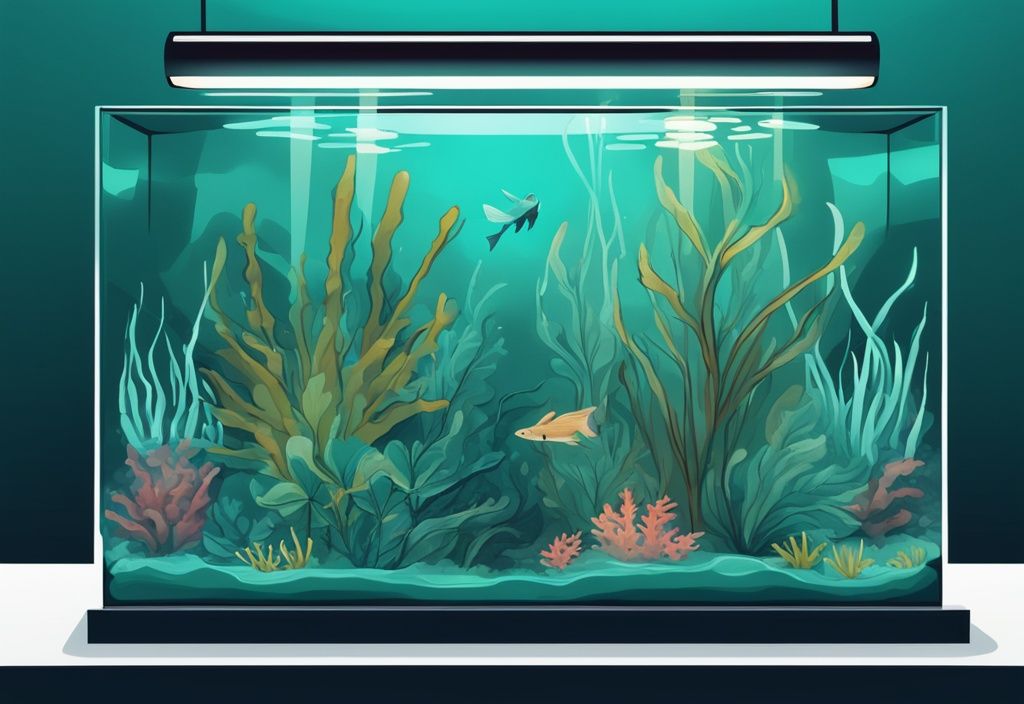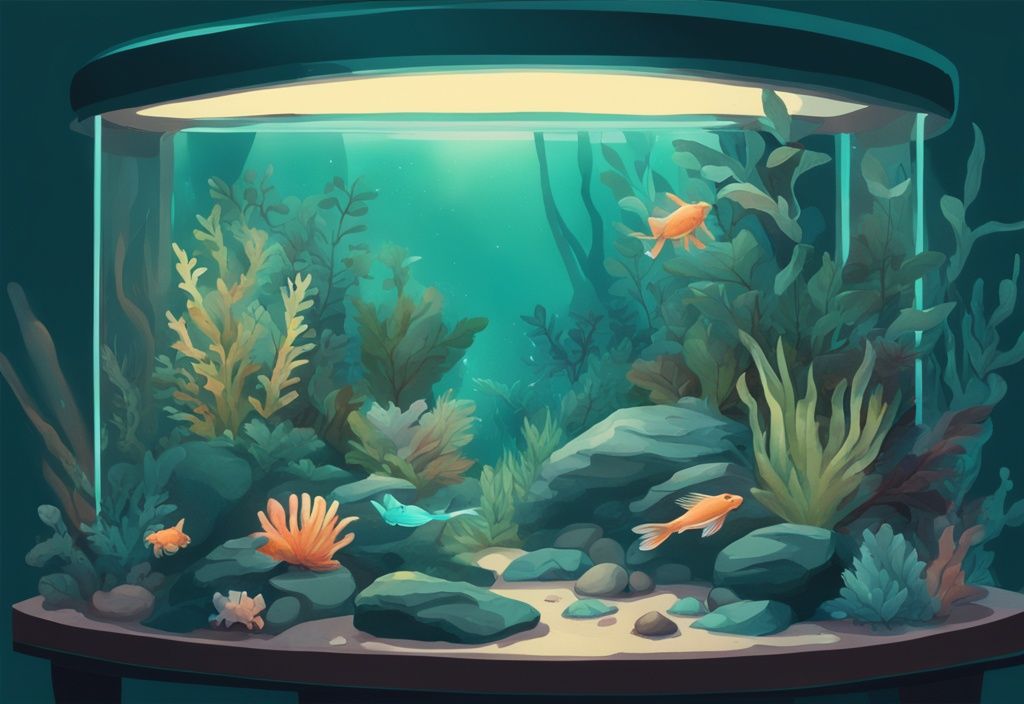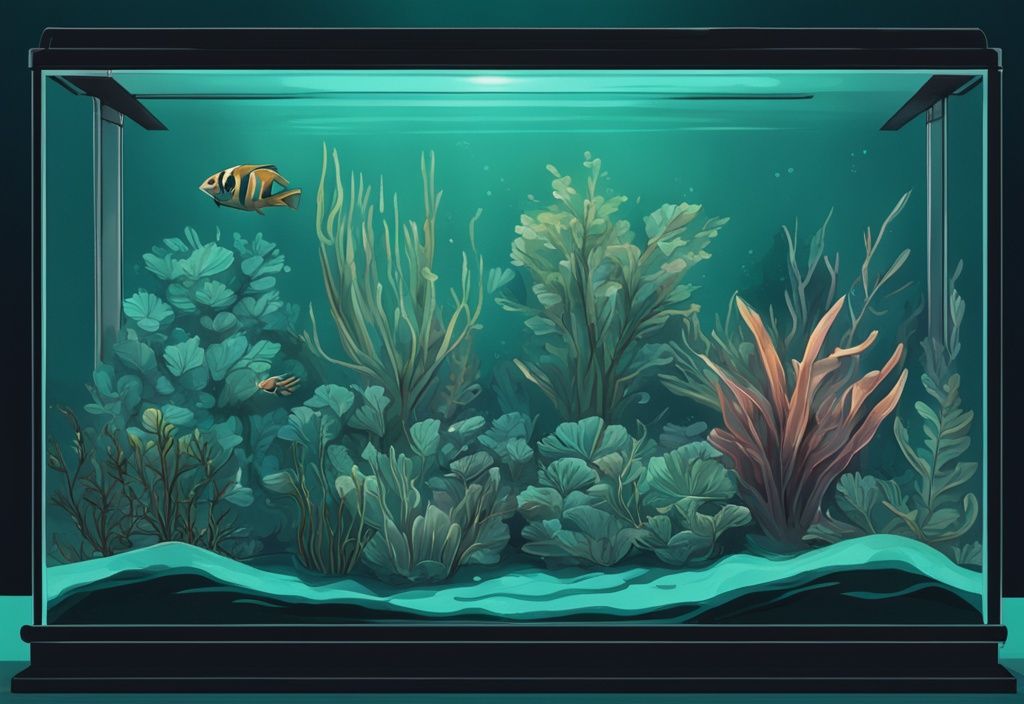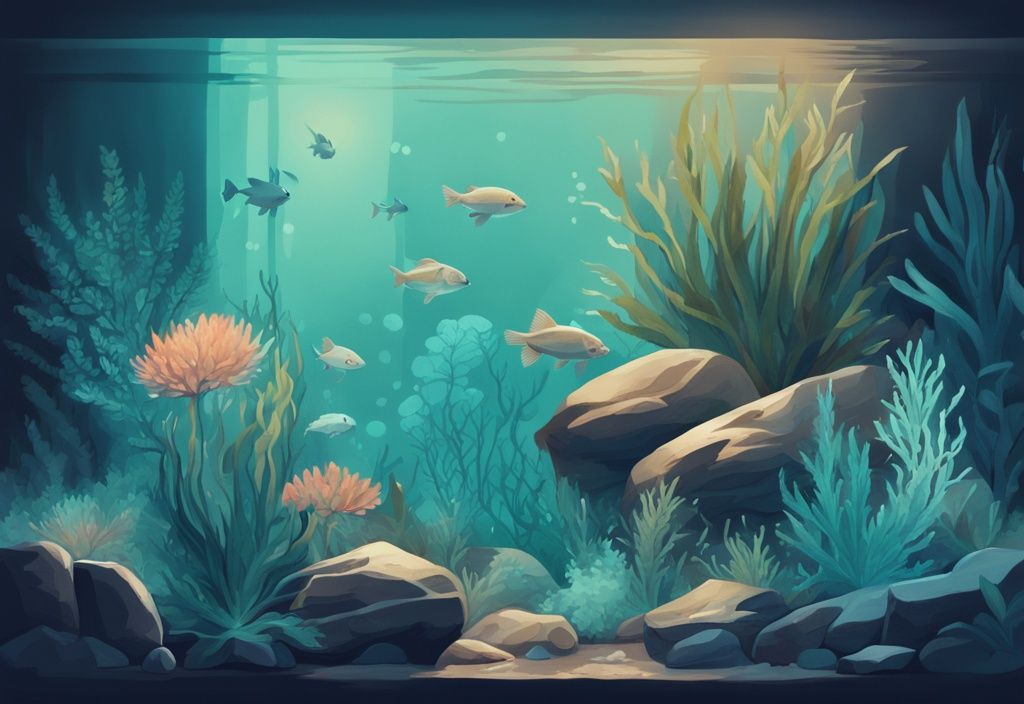Did you know low light aquarium plants could turn your ordinary fish tank into an aquatic paradise, even in dim conditions? As a marine biologist with over two decades of experience, I have a deep appreciation for these resilient, low maintenance plants, and I’m eager to share my knowledge with you.
This insight-filled guide, penned from my extensive expertise, sheds light on the unassuming beauty and practical benefits of low light aquarium plants. From selecting the most suitable species to understanding their care, I’ll navigate you through every step.
Presented through a warm and approachable lens, here’s your roadmap to cultivating a thriving underwater garden. Lean back, curious aquarist, and prepare to explore the understated charms of these hardy, algae combating powerhouses, and let your aquatic journey begin in earnest.
Understanding Low Light Aquarium Plants
Low light aquarium plants are a fascinating and essential aspect of aquatic ecosystems within home tanks. By understanding their unique needs and benefits, you can create a thriving underwater landscape that promotes healthy fish and plant life, as discussed in various studies on aquatic ecosystems, including an insightful article available here: View PDF.
Definition of Low Light Aquarium Plants:
Low light aquarium plants thrive in environments with lighting conditions of 10-20 PAR (Photosynthetically Active Radiation). These resilient plants are perfect for aquariums that lack specialized lighting equipment; they are hardy, low-maintenance, and capable of performing photosynthesis under lower light levels.
Why Choose Low Light Aquarium Plants?
Opting for low light aquarium plants offers numerous advantages, especially for beginners, due to their minimal maintenance requirements. Think of these plants as the unsung heroes of your tank’s ecosystem.
Firstly, they are excellent at absorbing waste products and producing oxygen, significantly enhancing the water quality. Imagine your underwater friends swimming in cleaner, fresher water—it’s like a breath of fresh air for fish! These plants contribute to the overall health of the aquarium environment.
Additionally, low light aquarium plants provide natural hiding spots and grazing areas for fish, effectively enhancing their sense of security and natural behaviors. Picture your fish darting in and out of lush greenery, feeling safe and at home. It’s not just beneficial for the fish, but also a joy to watch.
These plants also excel at controlling algae growth. By outcompeting algae for nutrients, they maintain a cleaner and more balanced tank, reducing your cleaning efforts significantly. It’s as if you have little underwater gardeners working tirelessly to keep the aquarium pristine.
Lastly, low light aquarium plants offer unparalleled versatility in aquascaping. Whether you’re aiming for a dense jungle or a minimalist Zen garden, these plants give you the freedom to create diverse and aesthetically pleasing underwater landscapes. It’s all about letting your creativity flow and transforming your aquarium into a visual masterpiece.
Choosing Your Low Light Aquarium Plants
Selecting the right plants for your aquarium can dramatically enhance the visual appeal and ecological balance of your tank.
Below, explore top options for foreground, midground, background, and floating plants that thrive in low light conditions.
Top Low Light Foreground Plants
Dwarf Hairgrass:
Dwarf Hairgrass is a prime choice for aquarists seeking to create a lush, grassy carpet in their tank. This low light aquarium plant thrives even under minimal lighting conditions, making it ideal for areas of the tank that receive less illumination. It enhances the foreground by adding a rich texture, offering visual appeal.
Another advantage is its low maintenance requirement; it only needs occasional trimming to maintain a tidy, natural appearance. This makes it a suitable option for aquascapers at any skill level.
Dwarf Sagittaria:
Dwarf Sagittaria is celebrated among aquarists for its ability to form dense, compact carpets, making it a perfect foreground plant. It is a hardy plant that can adapt to various water conditions and thrives in low light settings.
Its robust nature ensures it can withstand fluctuating parameters, ensuring longevity and sustained beauty in the aquarium. This versatility, combined with its easy-to-manage growth, makes it an excellent choice for beginners and experienced aquarists alike.

Midground Low Light Plants
Java Fern:
Java Fern stands out due to its exceptional hardiness and minimal care requirements. This low light aquarium plant flourishes when attached to rocks or driftwood, providing a natural and aesthetic enhancement to the midground of the tank.
It can thrive under varying water conditions, adapting comfortably to different water parameters, and needing only minimal light. Its resilience and ease of care make Java Fern a popular choice for both novice and experienced aquarium enthusiasts.
Anubias Barteri:
Anubias Barteri is renowned for its slow growth rate and low light requirements. This hearty plant thrives when anchored to hard surfaces like rocks or driftwood, adding structural elements to the aquarium’s midground.
It features broad, robust leaves that offer both aesthetic appeal and practical benefits, such as providing hiding spots for fish. The minimal maintenance needs make Anubias Barteri an ideal choice for aquarists aiming for a hands-off approach while still achieving a vibrant tank.
Low Light Plants for Background
Amazon Sword:
Amazon Sword is a versatile low light aquarium plant that can grow to substantial sizes, making it an excellent background choice. It thrives even in environments with limited light, providing a striking focal point in the tank.
This plant not only adds visual interest with its large, broad leaves but also serves practical functions by offering shelter and coverage for fish. Its ability to adapt to different conditions makes it a reliable option for creating a lush backdrop in the aquarium.
Water Wisteria:
Water Wisteria is highly adaptable to various lighting conditions, making it an excellent addition to low light tanks. Its fast-growing nature helps in adding vertical dimension and dense foliage to the background.
This plant is not only visually captivating but also aids in maintaining water quality by absorbing excess nutrients, thereby reducing the likelihood of algae growth. Water Wisteria’s rapid growth and versatility make it a favorite among aquarists seeking to enhance the background of their tanks.
Best Floating Low Light Plants
Christmas Moss:
Christmas Moss is an ideal floating plant for low light aquariums. This plant can be anchored to surfaces or left to float, providing flexibility in tank design. Its ability to thrive in low light conditions makes it a valuable addition, adding a natural, textured look to the tank.
Christmas Moss is not only aesthetically pleasing but also offers practical benefits, such as providing hiding spots for small fish and invertebrates, enhancing the overall ecosystem of the aquarium.
Caring For Low Light Aquarium Plants
Ideal Lighting Levels:
To ensure your low light aquarium plants thrive, maintaining lighting within the range of 10-20 PAR (Photosynthetically Active Radiation) is essential. This level is optimal for these plant species and promotes healthy growth. Aim for approximately 0.25 to 0.5 watts per gallon of water to achieve the right balance. It’s like finding the Goldilocks zone—not too bright, not too dim, just right.
Moreover, avoid subjecting your aquarium to direct sunlight. Think of it this way: while a little sun seems harmless, too much can lead to excessive algae growth. Algae competes with your plants for vital nutrients, almost like unwanted guests hogging all the food at a party. Keeping the lighting in check helps your low light aquarium plants flourish undisturbed.
Required Water Parameters:
The appropriate water parameters are pivotal for the health of low light aquarium plants. These plants flourish in temperatures ranging from 22 to 28 degrees Celsius. Imagine it as a tropical vacation spot—comfortable, inviting, and ideal for growth. Additionally, strive to maintain a pH level between 6.0 and 7.5. Regularly testing the water ensures these parameters remain stable.
Fluctuations can stress the plants and hinder their growth, similar to how we might feel under constant change and stress. Stable water parameters are like a reassuring routine that helps the plants stay healthy and strong.
Substrate and Nutrition Needs:
Low light aquarium plants benefit significantly from nutrient-rich substrates. These substrates are like a fertile garden bed, providing essential nutrients directly to the roots and supporting robust growth. If using a standard substrate, consider supplementing with root tabs. It’s like giving your plants a nutritional boost, ensuring they receive the nourishment they need.
Occasional fertilization is also beneficial. Think of it as feeding your plants a balanced diet to maintain their health and vibrancy. Using a balanced liquid fertilizer can help achieve this. Choose substrates that facilitate root development, enabling the plants to anchor securely and access nutrients efficiently. This solid foundation is crucial, akin to how a good diet and stable home environment support our well-being.

Solving Common Low Light Plant Issues
Understanding and addressing the common challenges associated with low light aquarium plants is essential for creating a thriving and balanced aquatic environment. Let’s delve into some frequent issues you might encounter and explore practical solutions to keep your plants healthy and vibrant.
Fixing Yellow Leaves:
Yellow leaves are a common signal that your low light aquarium plants might be suffering from nutrient deficiencies. It’s a bit like when we’re feeling under the weather and need a vitamin boost! To tackle this, you should regularly fertilize the tank. A comprehensive fertilizer is your best bet, ensuring your plants get a balanced mix of essential nutrients, particularly iron, potassium, and magnesium.
Think of it as giving your plants a well-rounded diet. Pay attention to their needs and adjust your fertilization routine accordingly. Regular monitoring will help you catch any deficiencies early and keep your plants looking their best.
Preventing Algae Growth:
Algae can be quite the uninvited guest in your tank. The key to keeping algae at bay, especially in a low light setting, lies in maintaining balanced lighting levels. Too much or too little light can tip the scales in favor of algae growth.
Additionally, overfeeding your fish can lead to uneaten food decomposing, releasing nutrients that algae love. It’s like leaving crumbs on the counter – an open invitation for pests!
If you’re managing a cold water aquarium, maintaining the right balance is crucial to prevent algae issues. Plant your aquarium densely with low light plants to outcompete the algae for these nutrients. This dense planting will create a more challenging environment for algae to thrive, keeping your tank cleaner and healthier.
Boosting Slow Plant Growth:
If your low light aquarium plants are growing at a snail’s pace, it’s time to reassess your lighting and fertilization schedules. Ensure your plants are receiving the appropriate light intensity, typically around 10-20 PAR. Adjustments here can make a significant difference.
Fine-tuning your fertilization routine to include all necessary nutrients is equally important. While low light plants generally don’t require high levels of CO2, ensuring a sufficient supply can sometimes accelerate growth. It’s akin to giving them a little extra push!
Regularly check these factors and you’ll find your plants growing healthier and more vigorously. It’s all about creating the right balance to nourish your aquatic garden.
Creating a Low Light Aquascape
How to Pick the Right Plants:
When selecting low light aquarium plants for your aquascape, several factors need consideration to ensure a thriving environment. Firstly, evaluate the size of your tank. Smaller tanks can benefit from compact plants such as Dwarf Hairgrass or Anubias Nana, which provide aesthetic appeal without overwhelming the space. For larger tanks, consider robust species like Amazon Sword or Water Wisteria for a striking visual impact.
Compatibility with your aquarium’s inhabitants is crucial. Ensure the chosen plants can coexist harmoniously with your fish. For instance, avoid fish species that are known to uproot or excessively nibble on plants. Additionally, take into account your overall aquascaping goals, such as the desired visual theme and color palette.
Low light aquarium plants come with diverse growth rates and maintenance needs. Dwarf Sagittaria and Cryptocoryne Wendtii “Red” are excellent choices for beginners due to their hardy nature and minimal care requirements. More experienced aquarists might opt for species with specific needs, ensuring they can provide the necessary conditions, like occasional fertilization or specialized substrate.
Basic Aquascaping Techniques:
Creating a visually appealing aquascape involves thoughtful arrangement and strategic placement of plants. Begin by planning the layout in terms of foreground, midground, and background areas. Foreground plants like Dwarf Hairgrass serve as a lush green carpet, creating depth and contrast with taller midground and background plants.
Incorporate hardscape elements such as rocks and driftwood. These not only enrich the tank’s natural look but also provide anchor points for plants like Java Fern and Anubias Barteri. Position these elements to form natural boundaries and enhance the visual flow of the aquascape. To ensure your aquascape remains pristine, consider reading our best fish tank gravel cleaner review. Regular pruning is essential to maintain the desired shape and prevent overgrowth. Trimming plants such as Dwarf Sagittaria keeps them low and dense, while periodic maintenance of faster-growing species like Water Wisteria ensures they do not overshadow other plants. Consistent care promotes a balanced and harmonious aquarium layout.
Ideal Tankmates for Low Light Plants:
Choosing the right fish species is vital for the health of your low light aquarium plants. Opt for fish that are plant-friendly and do not pose a risk of damaging or consuming the vegetation. Small, peaceful fish like tetras, rasboras, and small catfishes are excellent choices as they coexist well with planted environments.

Avoid larger, plant-eating species such as goldfish or cichlids, which can uproot plants and cause significant disruption. Ideal tankmates should be active yet gentle, enhancing the tank’s vitality without compromising plant health.
A well-planned aquascape featuring low light plants and compatible fish ensures a thriving and visually stunning aquarium environment. Balancing plant growth with the right aquatic life forms a cohesive and dynamic aquatic ecosystem that appeals both to aquarists and their underwater worlds.
Conclusion
Incorporating low light aquarium plants into your tank can be a rewarding and aesthetically pleasing endeavor. These plants thrive in environments with 10-20 PAR, making them a perfect choice for tanks with limited or no specialized lighting equipment. Their hardy nature and low maintenance requirements make them ideal for beginners and experienced aquarists alike.
Firstly, low light aquarium plants play a crucial role in enhancing water quality. By absorbing waste products and releasing oxygen, they contribute to a healthier ecosystem. These plants offer natural hiding spots and grazing areas for fish, promoting a more natural and stress-free habitat. Additionally, they help reduce algae growth by competing for nutrients, thereby maintaining a cleaner and more balanced tank environment.
When selecting low light plants, consider their placement in your aquarium. Foreground plants like Dwarf Hairgrass and Dwarf Sagittaria create a lush, green carpet, adding depth and texture. Midground choices such as Java Fern and Anubias Barteri offer robust foliage and can be anchored to rocks or driftwood. For the background, Amazon Sword and Water Wisteria provide height and coverage, making your tank visually appealing.
Caring for these plants is relatively straightforward. Maintaining lighting levels at 10-20 PAR, ensuring proper water parameters, and using nutrient-rich substrates or root tabs are key steps. Regular fertilization and occasional pruning will keep your plants healthy and thriving.
Addressing common issues such as yellow leaves, algae growth, and slow plant growth is essential to maintaining a vibrant tank. Regular fertilization, balanced lighting, and avoiding overfeeding can prevent such problems. Additionally, incorporating a variety of plants ensures a competitive environment, further reducing the risk of algae.
Creating a low light aquascape involves selecting the right plants based on tank size, fish compatibility, and aesthetic preference. Basic aquascaping techniques like arranging plants for visual depth and using rocks and driftwood can enhance the natural look of your tank. Choosing compatible tankmates, such as tetras and small catfishes, will ensure a harmonious environment.
In conclusion, low light aquarium plants are a versatile and beneficial addition to any tank. Their minimal maintenance needs, coupled with their ability to improve water quality and create a natural habitat, make them an excellent choice for aquarists of all levels. By carefully selecting and caring for these plants, you can create a beautiful, healthy, and thriving aquarium.
Frequently Asked Questions
Do Low Light Plants Require CO2 Supplementation?
Most low light aquarium plants thrive without the need for CO2 injection. While they might experience a slight growth boost with CO2, it’s generally unnecessary for their well-being. Think of it like an athlete taking a vitamin supplement—helpful, but not critical for success.
How Often Should Low Light Plants Be Fertilized?
Fertilizing low light aquarium plants should be occasional and tailored to their specific needs. The frequency varies based on the plant’s requirements and the overall tank conditions. Picture it like caring for a houseplant—each has its unique rhythm and needs.
Can Low Light Plants Grow in Any Water Conditions?
These plants are quite adaptable but do have their preferences. They flourish best in temperatures between 22-28 degrees Celsius and a pH range of 6.0-7.5. Think of these parameters as their comfort zone—a snug, cozy environment where they can truly thrive.
What Are the Top Low Light Plants for Beginners?
If you’re new to aquarium plants, start with hardy species like Java Fern, Anubias, Cryptocoryne Wendtii “Red,” Dwarf Sagittaria, and Marimo Moss Balls. These plants are the beginner’s dream team—tough, forgiving, and beautiful.
How to Prevent Algae in a Low Light Tank?
Preventing algae in a low light tank involves a mix of balanced lighting, avoiding overfeeding, conducting regular water changes, and densely planting your aquarium. Think of it as housecleaning—regular upkeep maintains harmony and prevents those unwanted “guests” from taking over.
